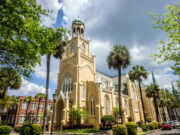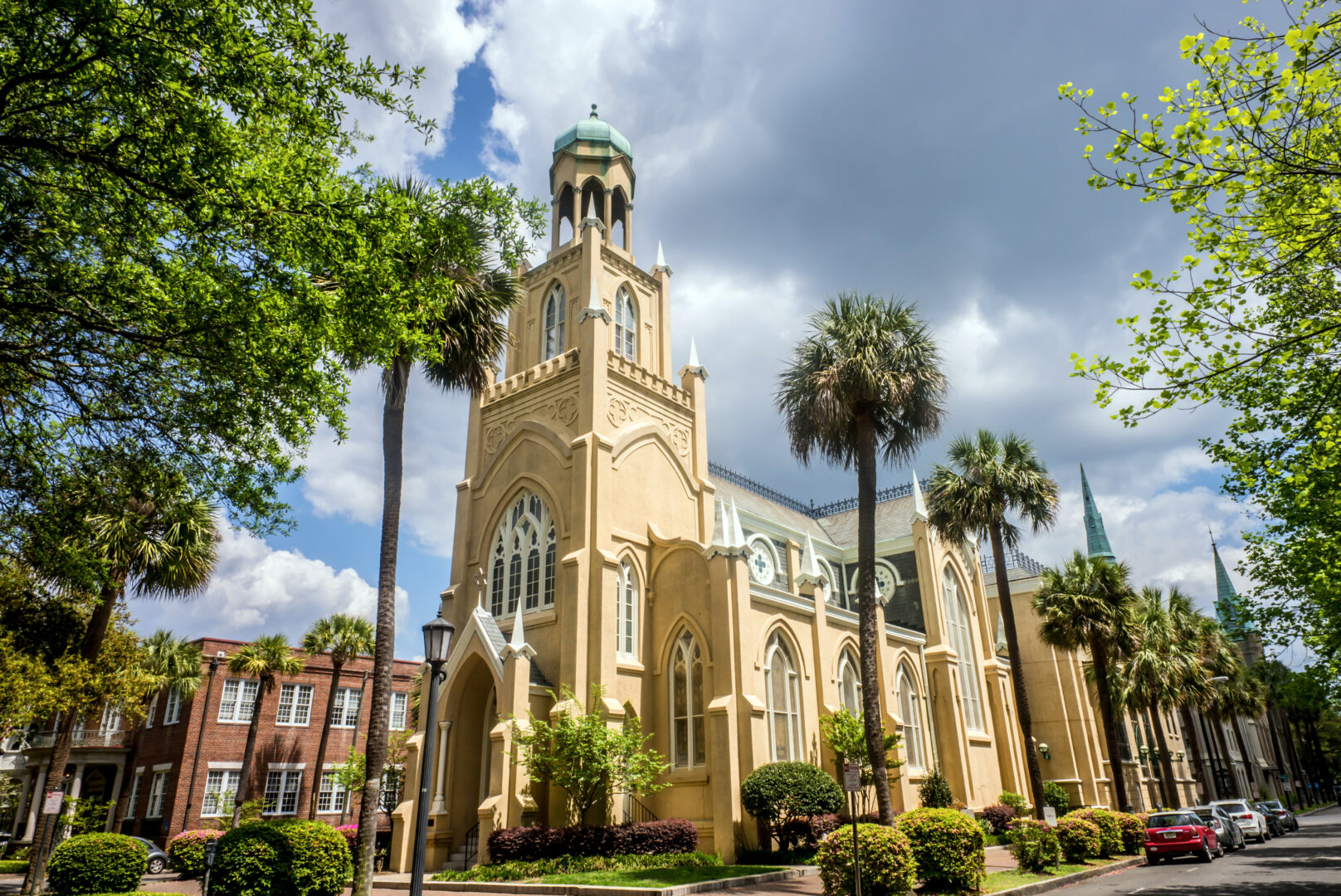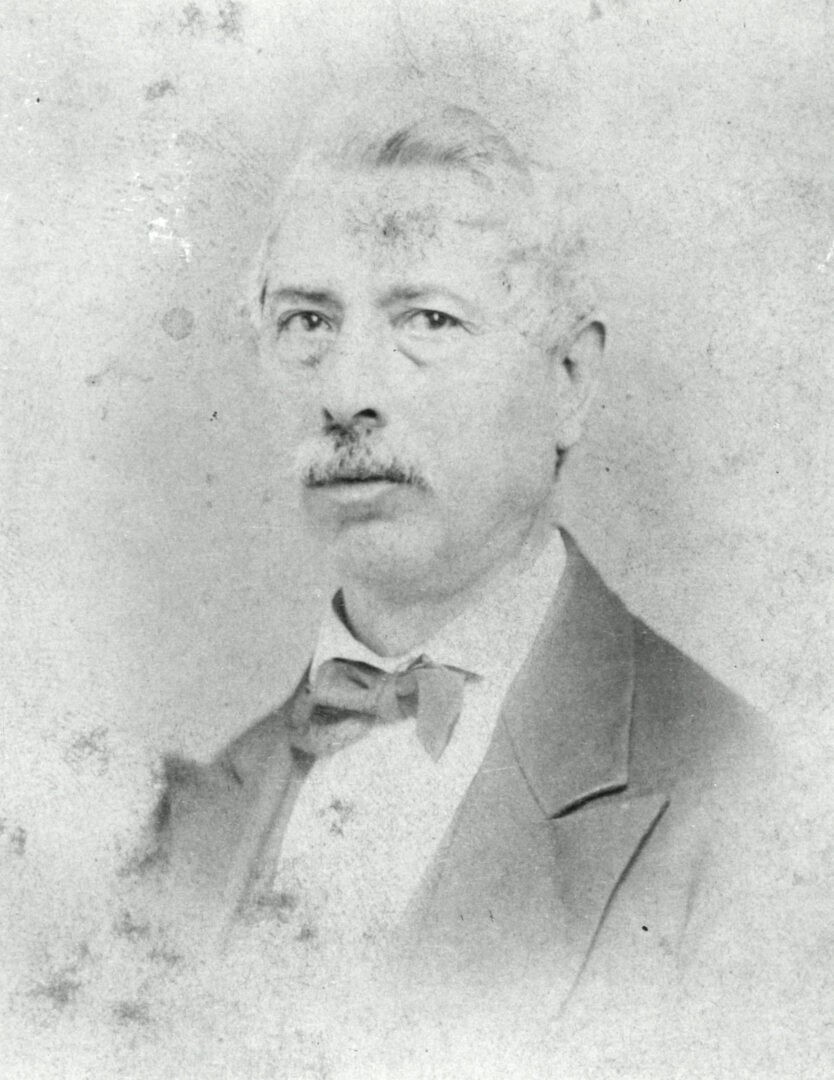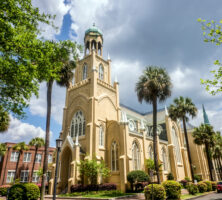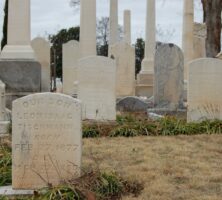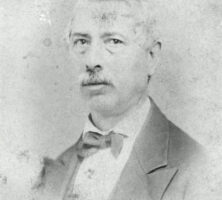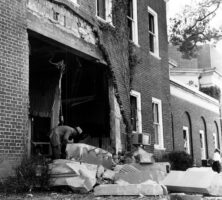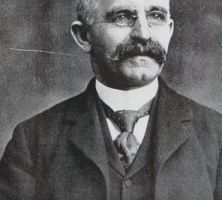Historian Ralph Melnick has written that “nearly everything one concludes from a study of Southern Jewry has its opposite that is equally true. . . . Nearly everywhere and in nearly everything some Jew has played a part. But it has been a marginal role.” The Jewish experience in Georgia has been no exception to this pattern. Since the inception of Georgia, Jews have at times played a central part in the development of the state, but they also have largely been considered outsiders.
Jews in Savannah
The first Jews to arrive in Georgia were a group of forty-two men and women who came on the schooner William and Sarah. They landed in Savannah on July 11, 1733, soon after founder James Edward Oglethorpe arrived with Georgia’s first settlers. Oglethorpe was surprised by the arrival of the new settlers, but at that point he had not received instructions from the Trustees with regard to non-Christian colonists. He was pleased to see among the group a physician, Samuel Nunes, whom he later credited with saving many colonists who were ill with yellow fever. Oglethorpe cited his gratitude to the doctor among his reasons for assigning plots of land to fourteen Jews. Among other reasons mentioned by scholars is the fact that another one of the Jews, Abraham de Lyon, had experience in viticulture, which would be useful to the colonists in their efforts to produce wine.
Strong internal disagreements about religious customs and language prevented these early Georgian Jews from building a synagogue. Their arguments stemmed from a centuries-old cultural division. Jews whose ancestors had lived on the Iberian peninsula until they were expelled during the Spanish Inquisition are known as Sephardim. Those who trace their lineage to other parts of Europe are known as Ashkenazim. The two branches have different liturgies, customs, and linguistic heritages: Sephardim spoke a Latin-based language called Ladino, while Ashkenazim spoke the German-based Yiddish.
Thirty-four of the Jewish arrivals in 1733 were Sephardim, most of them having fled from Portugal to England before departing for the New World. The Ashkenazic Jews felt mistreated by the more numerous Sephardic Jews. Indeed, in 1734 an Anglican clergyman in Savannah noted that, “Some Jews in Savannah complained . . . that the Spanish and Portuguese Jews persecute the German Jews in a way no Christian would persecute another Christian.” The internal feuding ended in 1741, during the War of Jenkins’ Ear, when the Sephardim, fearing Spanish invasion, fled to Charleston, South Carolina, and New York, leaving only the Sheftall and the Minis families, both Ashkenazim, in Georgia.
These two families were the leading Jewish families in colonial Georgia, with the Sheftalls being particularly influential. Benjamin Sheftall was the patriarch of the family, and he and his sons were active in the establishment of Congregation Mickve Israel (Hope of Israel) in July 1735, the third-oldest Jewish congregation in the United States (behind congregations in New York and Newport, Rhode Island). Sheftall had been a member of the first group of Jews to arrive in Georgia. The Torah scroll they brought with them from London is still in the possession of the Savannah congregation today. In 1748 Sheftall also had tefillin (phylacteries) brought over from England for the bar mitzvah of one of his sons, which was, according to Louis Schmier, “the first recorded observance of this rite in America.”

Photograph by Mark Kortum
Several members of the Sheftall family became prosperous entrepreneurs in the years preceding the American Revolution (1775-83) and took leading parts in the war itself. Benjamin Sheftall was one of the founders of the Union Society, the oldest charitable society in the state. His sons Mordecai, a large landowner as well as a merchant, and Levi, a flourishing tannery owner, joined their father in the influential Savannah Parochial Committee. This group, consisting mostly of merchants and artisans, sympathized with the patriot cause and took upon itself many of the functions of local government. Mordecai Sheftall was elected chair of the group for a term. Some of Savannah’s Jews lent considerable sums of money to the war effort, and some were appointed to military positions. Mordecai Sheftall became the highest-ranking Jewish officer on the American side, appointed deputy commissary general of issues to the Continental troops in South Carolina and Georgia.
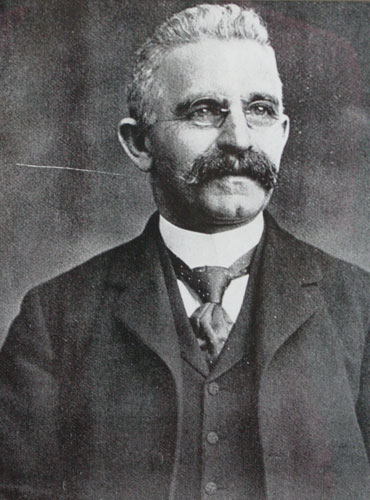
Photograph by Wikimedia
Historian Wayne Mixon notes that “Georgia’s Jews benefited from the increased religious liberty after the Revolution. Yet if the Jewish community grew, it was still largely confined to Savannah, which from 1786 to the middle of the next century had the state’s only synagogue.” Thus Jewish Savannahians continued through the decades to make an impact on Georgia and American life. For instance, Herman Myers was mayor of Savannah in the 1890s, and Savannah-born Rabbi Morris Samuel Lazaron served as a chaplain in the U.S. Army during World War I (1917-18); in 1921 he also represented American Jewry as one of four officiating chaplains attending the burial of the Unknown Soldier at Arlington National Cemetery in Washington, D.C.
Jews in Other Parts of Georgia
Savannah’s Jews may have had the first impact on Georgia history, but some Jews settled in other parts of the state and left their mark as well.
Three Ashkenazic families settled in Albany in 1846, ten years after its founding. During the next three decades additional Jews leaving Europe joined them, forming in 1854 the United Hebrew Society of Albany. No synagogue was built until 1882, however, when Temple B’nai Israel was erected. Albany was the home of one of the most colorful figures in Georgia’s Jewish history. Charles Wessolowsky, a Prussian immigrant and Confederate veteran who settled in the town, served the religious and moral needs of the area’s Jews for twenty-three years. An outspoken proponent of religious toleration and widely known to be well educated, he was respected by Albany residents of all religions. Wessolowsky was also prominent as associate editor of the Jewish South, the first Jewish newspaper in the South; as a public lecturer; and in various elective offices.
Raphael Moses, a resident of Columbus, was the chief supply officer for Confederate general James Longstreet during the Civil War (1861-65). Prior to the war, Moses participated in efforts to market Georgia’s peaches and plums, and he is credited with developing a technique for packing peaches that allowed the fruit to be shipped outside the South.
Morris B. Abram, an attorney, veteran of World War II (1941-45), and lifelong civil rights activist, was born in Fitzgerald. Among his many accomplishments were government appointments under five U.S. presidents and service as the U.S. representative to the Human Rights Commission of the United Nations.
Atlanta’s Jewish Population
Having been steered away from farming by historical circumstances (for example, many of the governments in Europe imposed restrictions on their owning land), Jews across Georgia tended to gravitate toward nonagricultural work. Thus the history of Georgia’s Jews finds most of them clustered in the more urban areas, especially Savannah and Atlanta; the latter has become the center of Georgia’s largest Jewish population.
At the time of the Civil War (1861-65), only 50 Jews lived in Atlanta; by 2000 the Jewish population had risen to 85,900. The first Jewish Atlantans were Jacob Haas and Henry Levi, who, with their families, settled there about 1846 to become shopkeepers. In 1860, responding to the needs of the Jewish poor during the Civil War, the community formed the Hebrew Benevolent Society. By 1867 they had obtained a charter for the Hebrew Benevolent Congregation, commonly known as “the Temple.” Members of the Temple are of the Reform denomination, which has its origins in mid-nineteenth century Europe. Twenty years later, Congregation Ahavath Achim (Brotherly Love) was founded in Atlanta, which in due course became associated with Conservative Judaism. Eventually, Atlanta grew to encompass numerous congregations representing a range of denominations or movements.
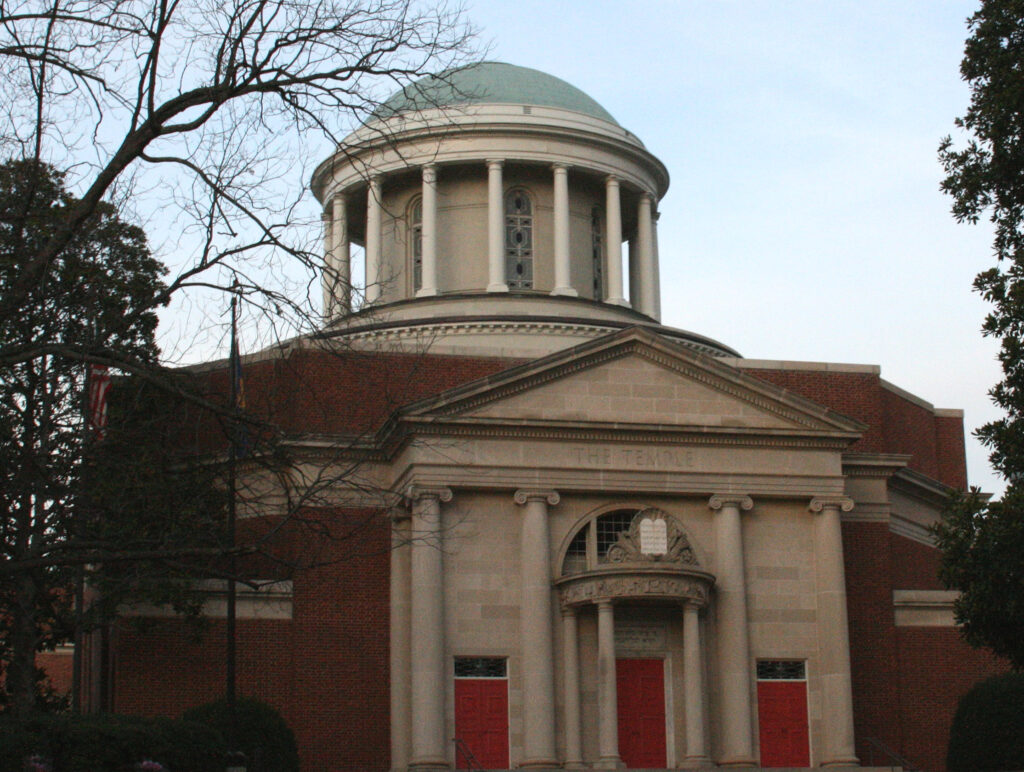
Photograph by David
Unlike the cultural split between Sephardic and Ashkenazic Jews, the main area of difference between and among the main Jewish denominations today has to do with the level of adherence to halakhah, the ideal lifestyle characterized by mitzvoth or commandments, with Orthodox Judaism being the most strict, Reform Judaism the least strict, and Conservative Judaism occupying a middle ground between the other two. Contemporary rabbi and author Joseph Telushkin provides an interesting comparison of these three groups by recording what happened when he co-chaired a symposium at which three prominent rabbis—one Orthodox, one Conservative, and one Reform—were each asked whether he perceived his own movement as the only authentic expression of Judaism. Telushkin reports that the Orthodox representative saw Orthodoxy as the only authentic Jewish religious movement; the Conservative rabbi said that he regarded Conservative Judaism as coming closest to the religion of Moses, though the other two groups were valid; and the Reform rabbi said that all three were sincere and equally legitimate expressions. Telushkin writes, “The three responses adequately summarize the attitudes that the three main Jewish denominations have toward one another.” One of the most obvious areas of difference among the movements today concerns gender roles and rights. For example, like the Roman Catholic Church, Orthodox Judaism opposes female ordination, while the other two branches allow female rabbis.
One of Atlanta’s early Jewish settlers, David Mayer, was another of Georgia’s most remarkable Jewish citizens. He moved from New York to Washington, Georgia, to practice dentistry, but in 1848 he joined Jacob Haas in the general merchandise business in Atlanta. When Haas left the business in 1851, the firm became David Mayer and Company. Mayer was a strong supporter of the Confederacy, serving on Governor Joseph E. Brown’s staff during the Civil War and as a blockade runner for the Confederacy. After the war he was instrumental in organizing the city’s public schools, serving with Brown on the first Atlanta Board of Education. Nearly one hundred years later, in 1969, after serving as Ivan Allen Jr.’s vice mayor for eight years, Sam Massell was elected as the city’s first Jewish mayor. Massell served one term and was followed by his own vice mayor, Maynard Jackson, who was the city’s first Black mayor.
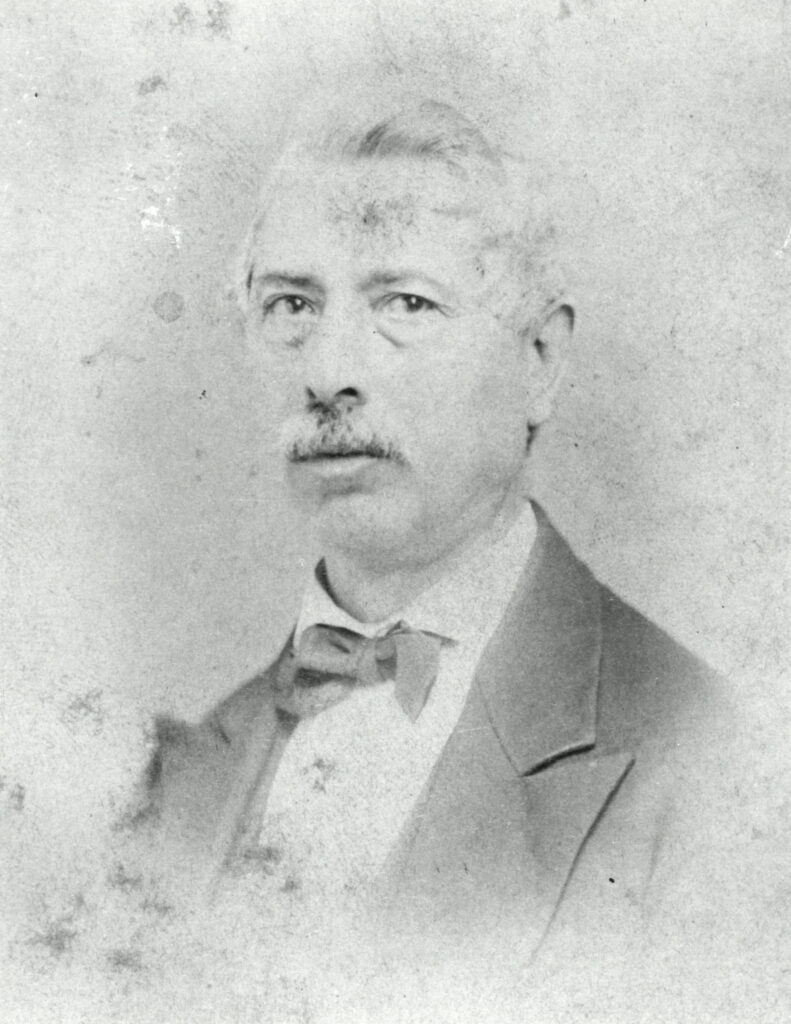
A remarkable record of Atlanta’s Jewish population is the Jewish section of historic Oakland Cemetery, which is currently a sprawling space of some eighty-eight acres in downtown Atlanta, the first six-acre section of which was created in 1850. The Hebrew Benevolent Congregation purchased land in the cemetery in 1878 and in 1892. Part of the latter purchase was in turn sold to the Ahavath Achim Congregation, which maximized use of its space by eliminating sidewalks. Thus visitors today to Oakland can see a thick cluster of Jewish grave markers, many of which feature Hebrew lettering and such Jewish symbols as the Magen David, or Star of David. Among the prominent figures buried in the Jewish section are Joe Jacobs, who owned a chain of drugstores. Historic preservationist Tevi Taliaferro points out that, “It was in Jacobs Pharmacy [in Five Points] in 1888 that a customer had a headache and asked that John Stith Pemberton’s tonic be mixed with seltzer water—and Coca-Cola was born.” Morris Rich, another famous Jewish figure buried at Oakland, moved from the Midwest to Atlanta and in 1867, at the age of nineteen, opened a small store that grew into Rich’s Department Store. Rich’s thrived for a century before being bought out by Macy’s.
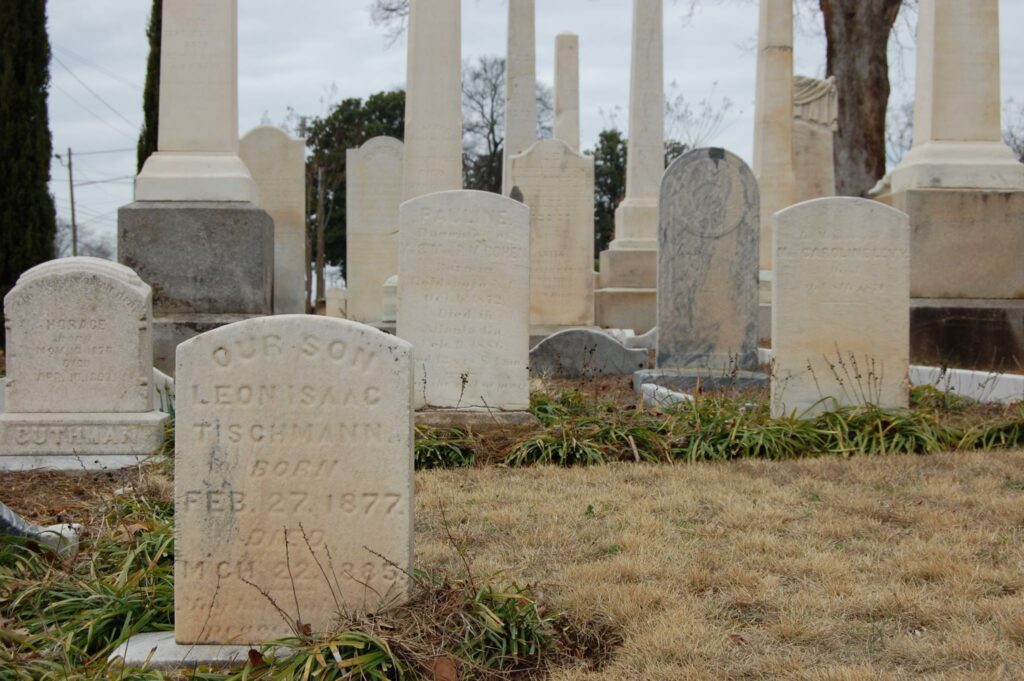
Photograph by Kate Wrightson
The Leo Frank Trial
In addition to such figures as Jacobs and Rich, Atlanta’s fame in connection with its Jewish citizens centers on two incidents, both grievous examples of anti-Semitism and the marginalization of Jews by accepted white society in Georgia. The first began with the trial and conviction of a Jewish pencil-factory superintendent, Leo Frank, for the murder of Mary Phagan, a thirteen-year-old employee, in 1913. Scholars generally agree today that Frank was almost certainly innocent of the crime. At the time, however, virtually all Georgians thought him guilty.
In 1915, following the commutation of Frank’s death sentence by Governor John M. Slaton, the Knights of Mary Phagan, a vigilante group, broke into the prison in Milledgeville that housed Frank and drove him to Marietta, where they lynched him. A few weeks later, on Thanksgiving Day, a reinvigorated Ku Klux Klan was formed on top of Stone Mountain by the one-time Methodis
In 1986 the Georgia State Board of Pardons and Paroles granted Leo Frank a posthumous pardon. A commemorative plaque, erected by the Jewish community of Cobb County, now marks the area where Frank was hanged; the plaque reads, “Leo Frank (1884-1915). Wrongly accused, Falsely convicted, Wantonly murdered.”
The Temple Bombing
The second major incident stemmed from anger at Jewish support for Blacks during the civil rights movement. The infamous dynamiting

Courtesy of Atlanta Journal-Constitution.
Just after the bombing, U.S. president Dwight D. Eisenhower remarked, “I think we would all share in the feeling of horror that any person would want to desecrate the holy place of any religion, be it a chapel, a cathedral, a mosque, a church, or a synagogue.” Support, including telegraphs, cards, and financial gifts, came from numerous Atlanta churches. Writer Melissa Fay Greene notes that such sympathy and fellowship from Christians in Atlanta led Rabbi Rothschild’s wife, Janice, to label the crime as “the Bomb that Healed.”
The Current Jewish Population
According to the American Religion Data Archive, there were fifty-two Jewish congregations in Georgia in 2000, with approximately 93,500 adherents. Not all Jews belong to a synagogue, however, and the number of Jews in Georgia certainly exceeds the number of adherents. Figures for the state’s major metropolitan areas are: Albany, one congregation with 200 adherents; Athens, one congregation with 400 adherents; Atlanta, thirty-four congregations with 85,900 adherents; Augusta, three congregations with 1,515 adherents; and Savannah, three congregations with 3,000 adherents. Between 1990 and 2000, the Jewish population in the Albany metropolitan area decreased by 50 percent, while those of the Athens and Atlanta metropolitan areas increased by about 33 percent each. Augusta’s Jewish population increased by 8.2 percent, Columbus’s by 10 percent, and Savannah’s by 9.1 percent during the same time.
In 1996 the William Breman Jewish Heritage Museum, which serves as an archive and cultural center dedicated to the experience of Jews in Georgia, opened in Atlanta.


